2019 Ford Ranger vs. 2020 Jeep Gladiator vs. 2019 Chevrolet Colorado vs. 2019 Honda Ridgeline
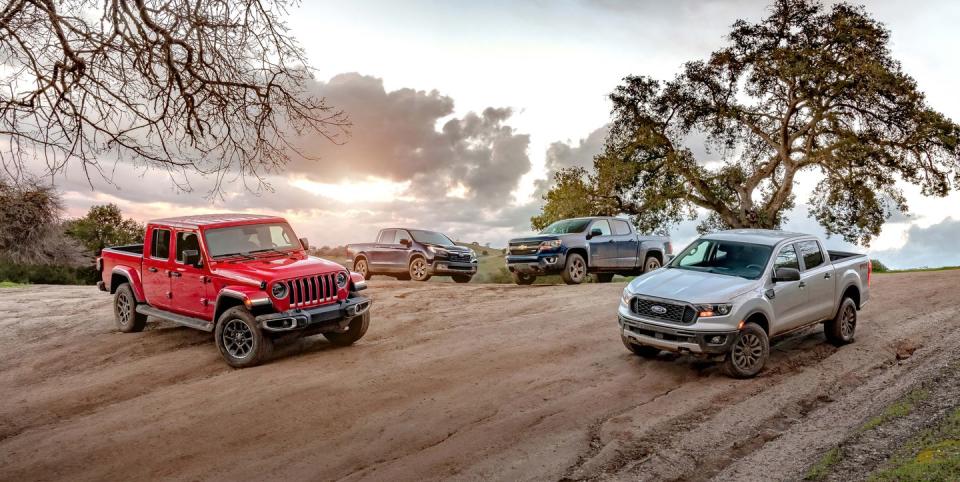
The pickup is as central to the American Dream as the white picket fence. It's not just the house and the 2.5 kids that we want, it's all the projects around that house, the Home Depot runs, the toys we can hitch up, and somewhere to play with them. And just because we're in a new era of global awareness and responsibility doesn't mean that dream has to die.
But it could be downsized to a more sustainable scale. Luckily, American truckmakers have you covered. Some people call them mid-size pickups; others point out that a middle implies a point between two extremes and therefore refer to these obviously-not-small things as compact trucks. Whatever you call them, after flirting with stagnation in the early part of the decade, the less-than-full-size-pickup market is booming again.
The rebirth started in 2014 when Chevrolet and GMC launched the Colorado and Canyon, respectively, on a sturdy new frame, substantially beefier than the global Colorado's. Sales of the Silverado and Sierra hardly hiccuped, while the smaller trucks' annual tally jumped from about 50,000 units to well beyond 100,000. They're represented here by a Colorado Z71, which was demoted in 2017 to second-most-capable off-roader in the Colorado lineup behind the ZR2 but still boasts a two-speed transfer case tucked behind a skid plate and a locking rear differential. With the towing package and a dealer-installed polished exhaust tip, the Colorado rings up at $38,955.
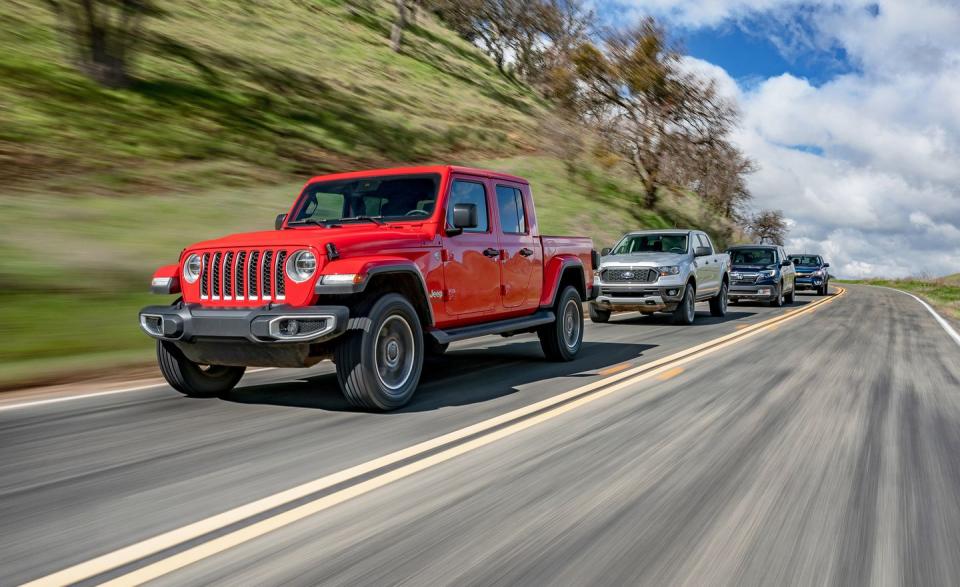
Honda was hoping for a rebirth when it unveiled the new Ridgeline for 2017, but that hasn't exactly panned out. The company readily admits that the problem with the first-generation pickup was that the styling was off-putting, but then it went ahead and made the next iteration of the truck just as unconventional as before. It's a shame, because for all its minivan-with-a-bed looks, the Ridgeline is a comfortable, capable thing for people who don't regularly tow 10,000 pounds. The Ridgeline comes in one cab configuration and one bed length, with one engine-and-transmission pair sending torque to either the front or all four wheels. A loaded-up RTL-E like the one we had stickers at $43,090.
Fans of the Ford Ranger-a phrase nearly as weird as "adult readers of Harry Potter"-had been crying out for the truck to return to the U.S. since the latest global version was unveiled in 2010. Buyers here can choose a smaller back seat with a longer bed or a bigger back seat and a shorter bed. Both rear- and four-wheel drive are available, but there's only one powertrain. If you want a Ranger, you get a 270-hp turbocharged 2.3-liter inline-four and a 10-speed automatic. Until Ford gives in and brings us a Raptor version, the optional FX4 package makes the top off-road Ranger. Ours checks in at $40,510.
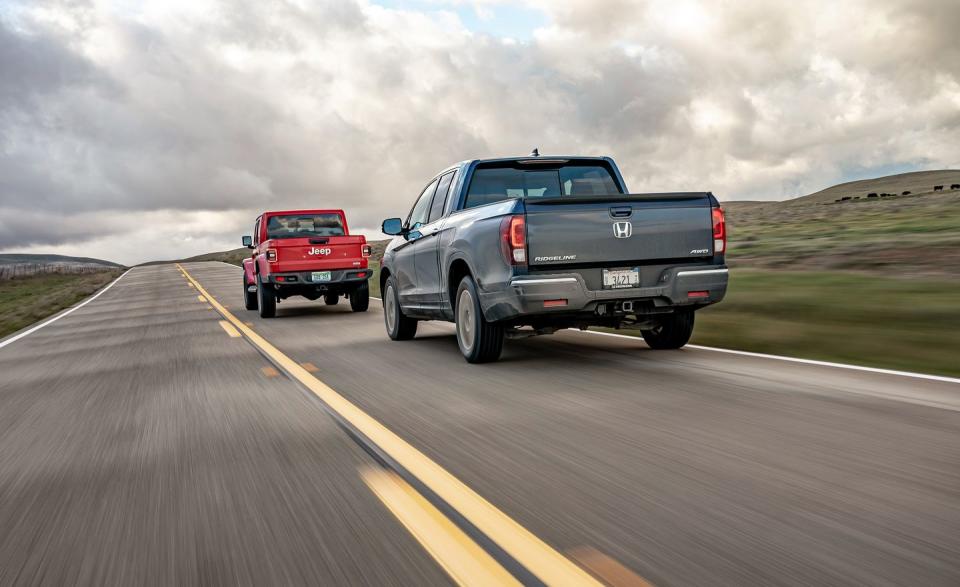
The most exciting thing to happen to this segment since NAPA started putting those hilariously lifelike giant hats on the Rangers in its delivery fleet is the Jeep Gladiator. It's kind of a Wrangler with a bed, except that it's way more than that. Jeep reengineered the entire back half of the frame so thoroughly that maximum payload jumps from 1000 pounds in the Wrangler to 1600 in certain truck trims. At 7650 pounds when optioned properly, the Gladiator's towing capacity not only exceeds the four-door Wrangler's by 4150 pounds and leads this class, but it approaches the ratings of the all-growed-up big trucks. With a starting price of $41,890 and an as-tested total of $55,485, our Overland model also rivals the big trucks in price.
Since sometimes these trucks are tools and sometimes they're toys, we expanded our usual testing regimen to get a fuller impression of their capabilities. We hooked each up to a small aluminum trailer with a Honda Pioneer side-by-side on it, a load of about 3500 pounds. Then we hit the highway, charting a course for Hollister Hills State Vehicular Recreational Area, an off-road park just outside of Hollister, California, where we got rained on, good and muddy, and only almost stuck.
Yes, we realize we're missing a Toyota Tacoma, and that Tacos have sold in massive numbers forever, and that this whole thing about the rebirth of the segment is a lie because the Tacoma has been the segment for the last decade. But the Tacoma is so ancient that the oldest living Galápagos tortoise could have been born in its back seat. And the Nissan Frontier is older than the Galápagos archipelago itself. The reason these trucks matter is that now Tacoma and Frontier owners can buy pickups that actually behave like modern vehicles. Well, not all of them.
4th Place:
Ford Ranger

Highs: Smooth powertrain, butch good looks.
Lows: Insufficiently reengineered from the version sold elsewhere in the world.
Verdict: If you're going to be late to the party, at least get it right.
We were excited about the Ranger. Ford took its sweet time bringing this truck here, and in the years since we first saw that broad-shouldered, swaggering profile on other shores, we've been ratcheting our expectations ever higher.
Ford says the North American Ranger has been significantly reengineered from the global version of the truck, but until we see a spreadsheet with different part numbers, we won't be convinced. Particularly telling was the headliner in our truck. The trailing edge was so rough that we wondered if it wasn't an SUV piece run through a band saw. We then argued at length about whether the scrap would be recycled into new headliners or used to make forts for the factory workers' kids.
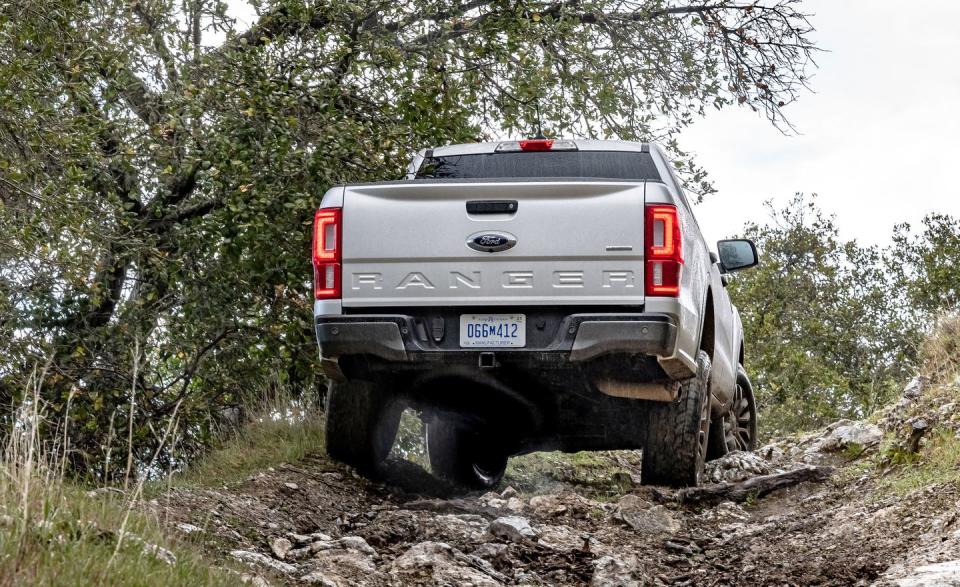
This half-finished feel extended to more important aspects, too. Woefully underdamped, the Ranger was always a second or two behind what the road was doing. And not only was its 193-foot stop from 70 mph the longest here, but the pedal feel was genuinely frightening. It sank through a couple of inches with no resistance or response and then grabbed with an immediacy that frequently had our heads bobbing.

At Hollister Hills, the Ford's Hankook Dynapro AT-M tires reminded us that, no matter the surface, tires make the difference. There's no surprise quite like driving up a mountain on a nice sunny day only to find it raining on the drive down. The Hankooks' chunky tread design grabbed the slick adobe mud by big, gooey handfuls and dragged the Ranger through the park with relative ease. Between the tires, a useful approach angle, and the fact that Ford calls its exposed steel front skid plate a "bash plate," the FX4 was clearly the better off-road package than Chevy's Z71.
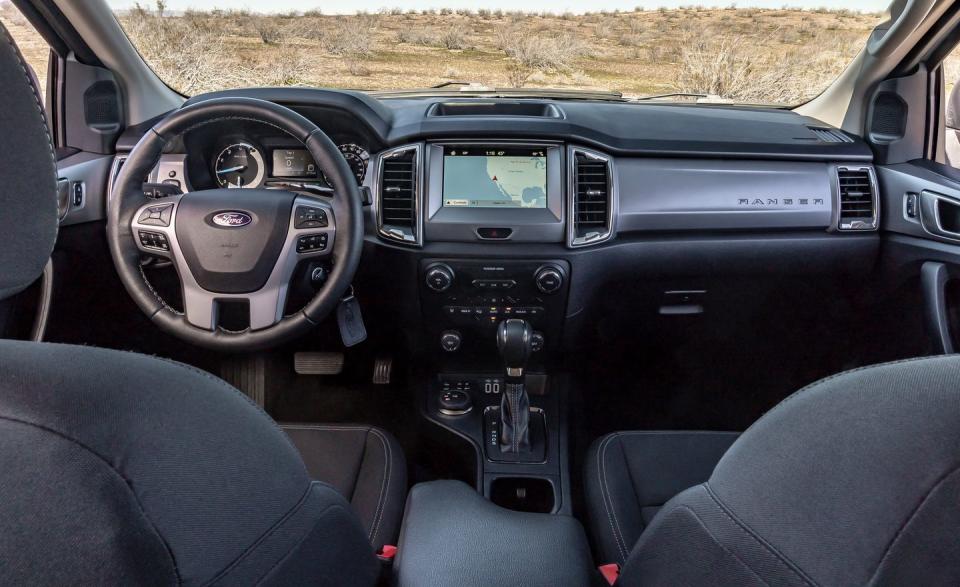
Towing the trailer wasn't enough to stress the trucks, but it did serve to showcase each one's strengths and weaknesses. In addition to raising-or should we say lowering?-the braking experience to truly alarming levels, attaching the trailer highlighted the EcoBoost four-cylinder's smooth, sturdy power delivery. The less-than-huge-pickup segment doesn't place a lot of emphasis on powertrain refinement, but this Ford's four-cylinder seems designed to smash that paradigm with velveteen output. Ten speeds appear to be more than the truck really needs, but shifts are at least quick and smooth, and the four-cylinder's broad mid-range means that it never feels overburdened no matter what's going on. In at least that one way, the Ford is a high-water mark that its competitors will be striving to meet with their next-generation trucks. But in every other way, the long-awaited Ranger feels not a year ahead but a generation behind.
3rd Place:
Jeep Gladiator
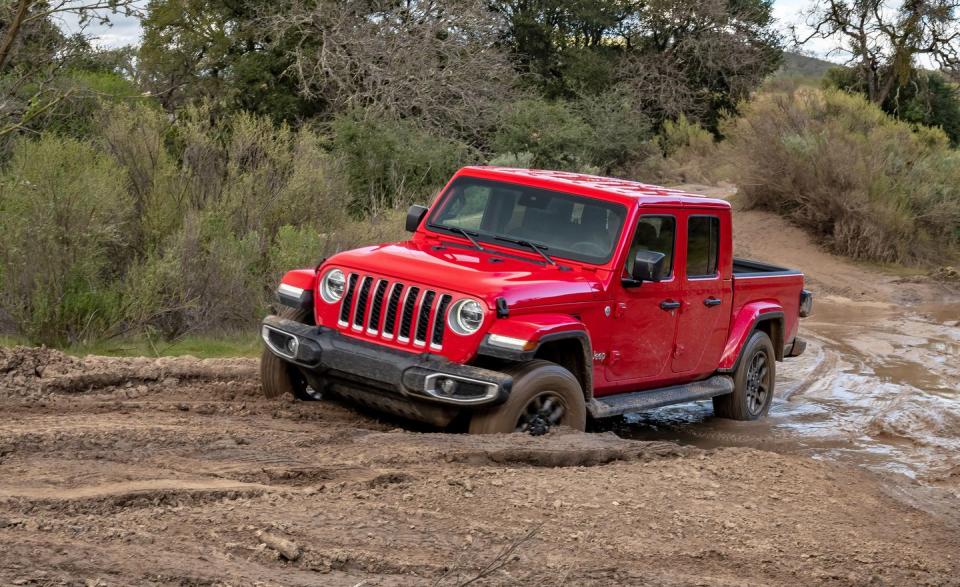
Highs: Have you heard? They're making Wranglers with pickup beds now!
Lows: Fifty-five large and that's not even the top of the pricing pyramid.
Verdict: You'll love it even when you don't want to.
The Jeep was, hands down, every voter's favorite. You can't not smile while driving it. It's like a golden retriever puppy. When you thumb the key fob of any of the others, you might glance over your shoulder to make sure the door locks engaged, but you run back to hug the Jeep. Heck, not only is it designed so that you can take the top and doors off, but all the necessary tools live in a little pouch in the glovebox, and tucked under one of the rear seats is a foam holder to keep track of the fasteners.
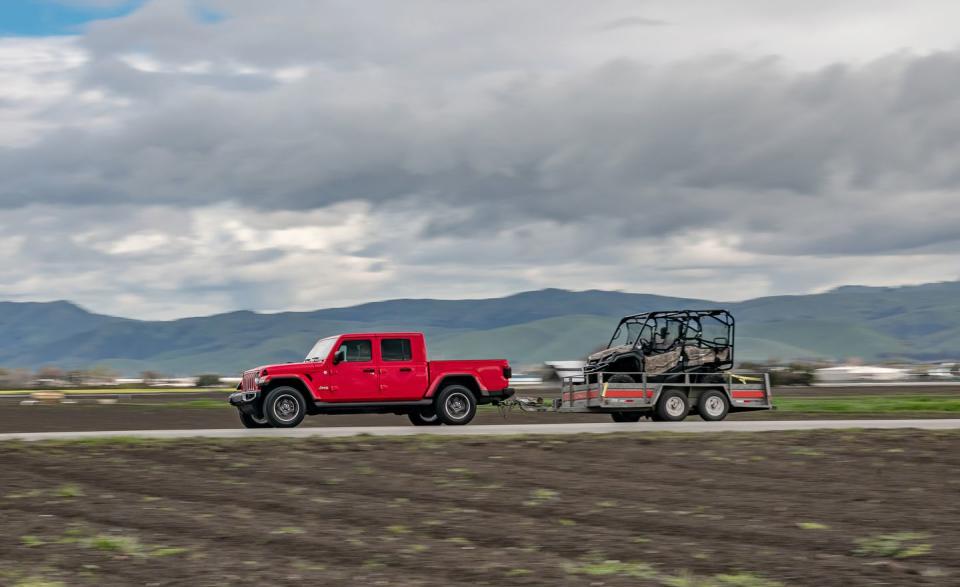
We so badly wanted to let this puppy play that we had to jump it. Surprisingly, that was the Wrangler pickup's best showing off-road. With the Overland trim's Bridgestone Dueler H/T 685 pavement-biased tires and at least nine more inches of wheelbase than any other competitor here, the Jeep was even less comfortable on Hollister Hills' slippery trails than the Honda, which senior editor Tony Quiroga dubbed a "dachshund." A dachshund might scrape its belly here and there, but even with 10.0 inches of ground clearance, the most in the test, the Gladiator would belly-flop into the mud with a wet thwap and noisily drag its frame rails over crests and bumps that the drivers of the Colorado and Ranger didn't notice.
It wasn't much better on-road. Consider the following radio exchange between vehicle testing director Dave VanderWerp in the Jeep and Quiroga in the Ford:
DV: Over one of those whoop-de-dos, the Jeep got so out of sorts that stability control intervened with a strong stab of the brakes . . .
TQ: There were whoop-de-dos?
DV: Exactly.
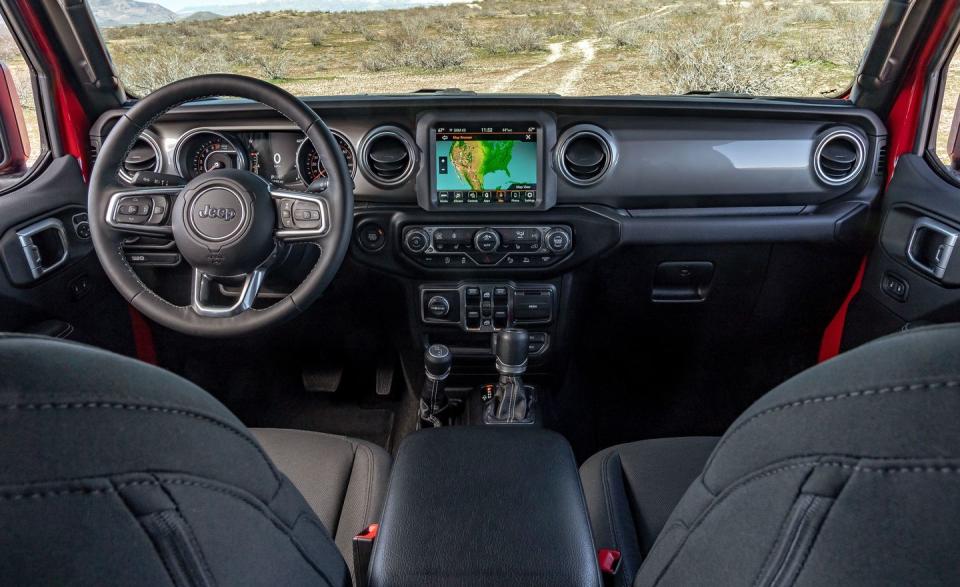
And yet, as wild as the Jeep's movements were, they were more consistent than the Ford's. Maybe it's because its suspension response was so slow that it missed entire events. Hit a stretch of washboard and the Jeep might react to only every third bump. And the Jeep responded best to the trailer, the tongue weight seeming to eat up some of the excess travel of the rear coil springs and calm the ride.
The Pentastar V-6 can feel a little crude in other applications, but here, it's right at home. Like the Wrangler, the Gladiator uses recirculating-ball steering, and it feels as if there's a lot of slack in the system. You need to scrunch up the balls and firm up the worm before anything will happen. But even that wasn't enough to turn anyone off the Jeep. We'll forgive a lot of dynamic sins for something that overflows with personality the way this truck does.
2nd Place:
Honda Ridgeline
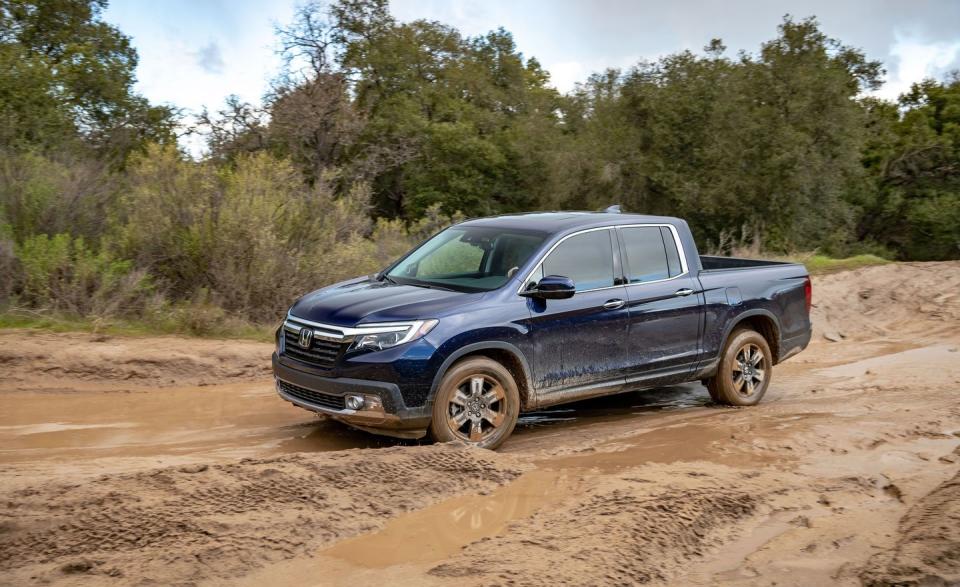
Highs: Everything pertaining to objective vehicular agreeability.
Lows: The minivan jabs hurt because they're true.
Verdict: What nearly every mid-size-pickup-truck buyer is actually looking for.
It's easy for other truck buyers to disrespect the Ridgeline. But it seems as if Honda's designers set them up for it. If you wanted to make it easy in this segment to serve up your product like a punching bag, you could always make it look like a minivan. The way the Ridgeline looks is the worst thing about it.
But the Ridgeline also acts and feels like a minivan in all the best ways. The cabin measurements of the four trucks are close, but the Ridgeline's interior is so airy and open that it feels as if you're flying a dirigible from inside the envelope-in the other trucks, you're down in the gondola. And that's just up front. The back seat of the Ridgeline is the only one an adult will voluntarily crawl into. And that seat easily folds tight against the back of the cab, leaving a massive space with a flat load floor, making it a cinch to transport a bunch of cargo in weather-tight security. Or you can put that stuff in the in-bed trunk, an idea that gets better the more you use it.
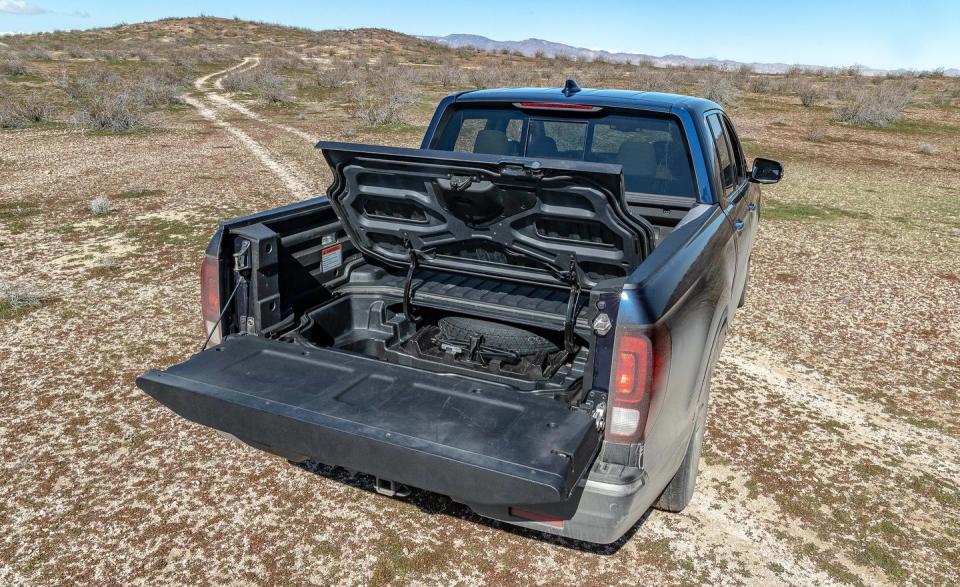
VanderWerp christened the Honda the "right-brain pickup." It's brimming with things that would feel gimmicky if they weren't so useful-well, except for the bedsides doubling as giant stereo speakers. That one's a gimmick.
While the Honda silenced the doubters with surprising competence in the towing and off-road tests, the additional stress revealed just how noisy its structure is. The suspension largely shrugged off the weight of the trailer, but the cab shuddered so badly that we had to check our hookup to make sure nothing was loose. When we got off-road, the groans as the body flexed over crests made clear that it's just not the most rigid body shell.
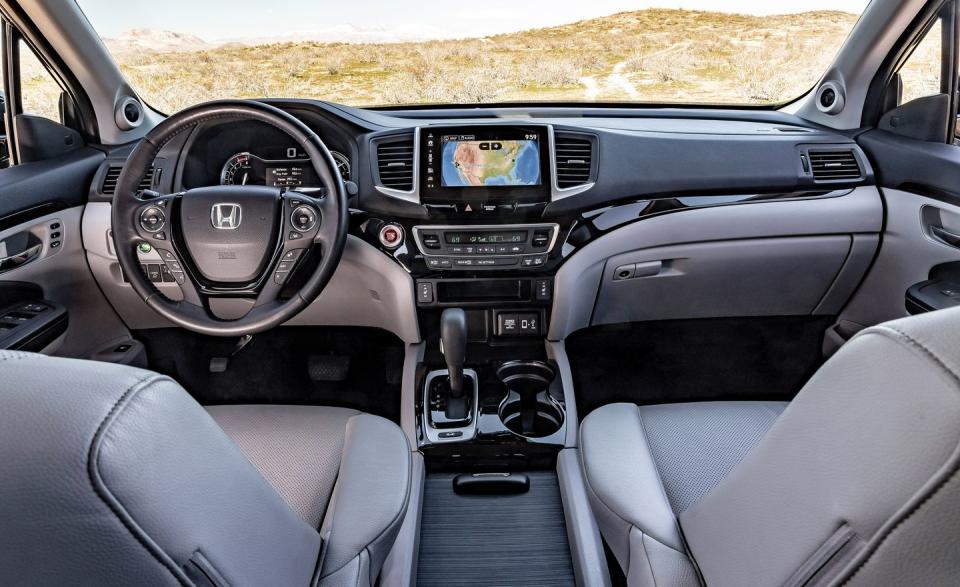
But the fundamental goodness of the powertrain and the Ridgeline's overall package are inescapable. The ride is imperturbable, control weights and responses are light and natural, and the view out and interior space are excellent. The Ridgeline presents many benefits of a car with enough capability to do truck stuff when necessary. The downside to this is that, as Quiroga put it, the Ridgeline is competent enough to be boring. The other trucks are fun to hustle because you know you're doing something dumb. In the Ridgeline, you're just comfortably and expediently getting where you're going. Most days, that's all we want. This time, though, it turns out we wanted something different.
1st Place:
Chevrolet Colorado
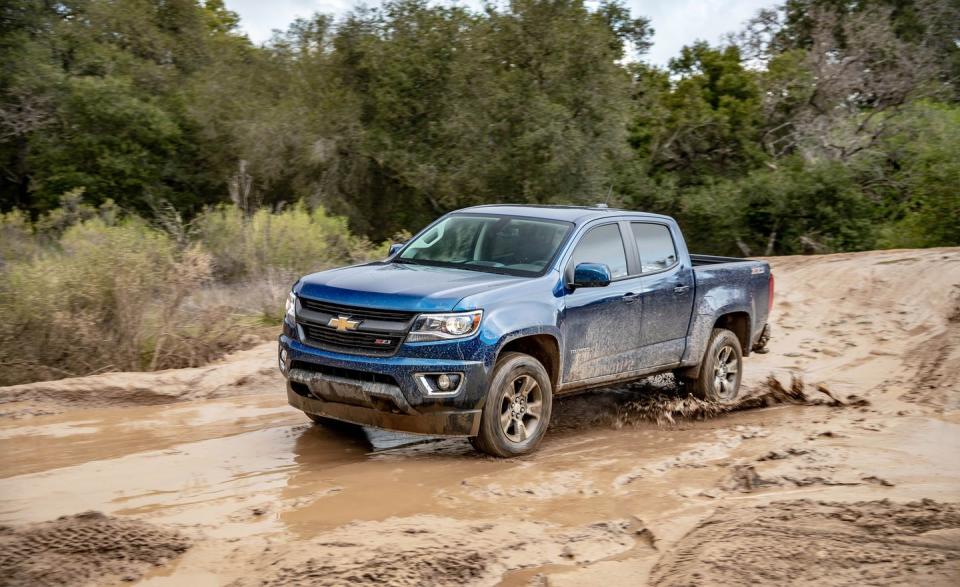
Highs: Compared with the others, it drives like a 911.
Lows: Well, a 911 with a gritty engine and a low-budget interior.
Verdict: Most of the virtues of the other trucks all rolled into one.
The days get long on comparison tests. Sometimes our attention wanes. Following a photo stop outside Buttonwillow, California, everybody was staring at their phones when photographer Marc Urbano pulled onto the road. When he radioed to ask if we were going to follow him, we scrambled our trucks and took off. In the wrong direction. For 15 minutes. With spotty cell coverage, it took that long for Urbano to get hold of one of us and tell us to turn around.
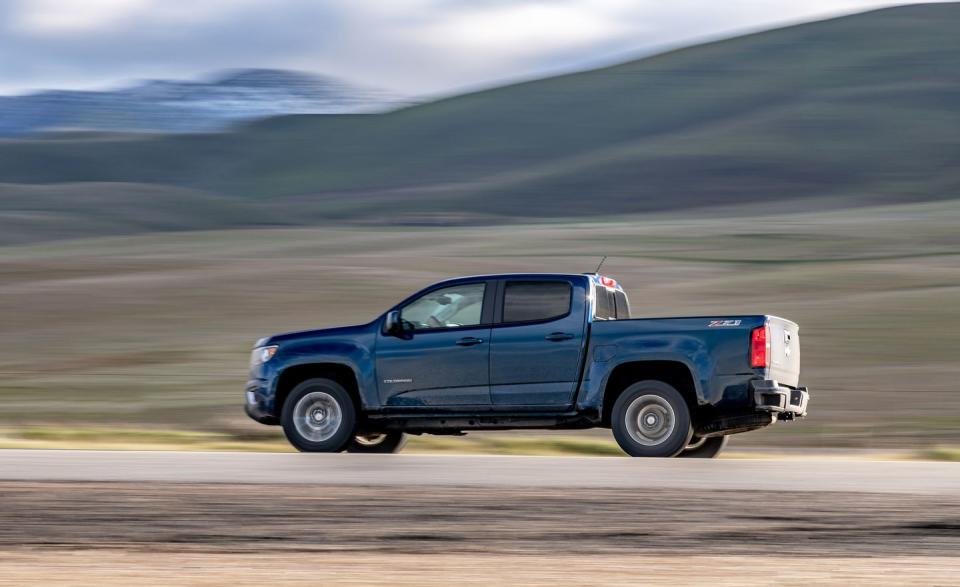
But when we whipped those 180s in the mountains, nobody was enjoying the canyon-road run as much as the guy in the Colorado. The Chevy's control feel and responses are the most sports-car-like in the class. Ride motions are clipped but perfectly damped. The brake pedal is Corvette firm, with natural modulation, and generated the shortest stop in the test. Even the Colorado's driving position is reminiscent of a car's, with the seat low to the floor and sheetmetal that cradles occupants without smothering them or ruining sightlines. Technical director Eric Tingwall called it "the best-driving body-on-frame vehicle on sale today."
We were less impressed with the Chevy's powertrain. The 3.6-liter thrashes around through much of the rev range, with nothing more than a gritty roar making it out of the engine room until the last couple hundred rpm before the fuel cutoff, when the sound resolves into something kind of stirring. And the transmission isn't much more couth, with unpredictable gear spacing and an overly aggressive upshift schedule that frequently had the revs lower than we wanted.
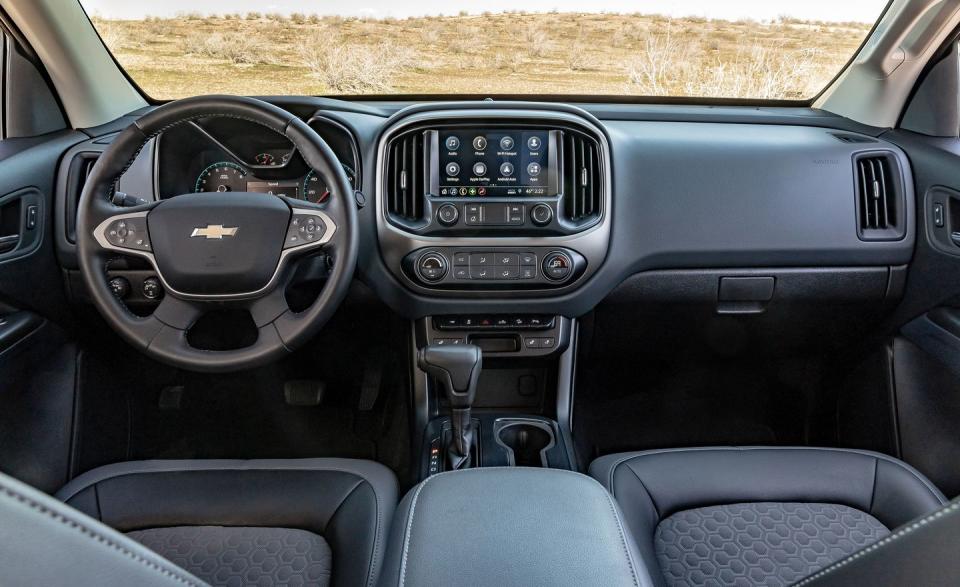
But the Colorado is a well-balanced package for tool and toy duties. In spite of having the test's second-lowest ground clearance, the Chevy acquitted itself well off-road. Somebody might have snagged the lower air dam on a mound and ripped it off, but we all agreed that this at-speed modification represented an improvement to the way the Colorado looks, and that even though there's a ZR2 above the Z71 in the off-road hierarchy, an off-road special really shouldn't have a vulnerable piece of black plastic hanging down beneath its chin. And while both the Chevy and the Ford wore the appropriate tires for Hollister Hills, the Ranger's Hankooks held the ground just a touch better when the mud started getting slick.
With the trailer hooked up, the Colorado's ride quality was barely changed. It still rode better than the Ford and Jeep. An outstanding toy and an effective tool, the Colorado wins because it excels no matter the task.
From the May 2019 issue
('You Might Also Like',)

 Yahoo Autos
Yahoo Autos 